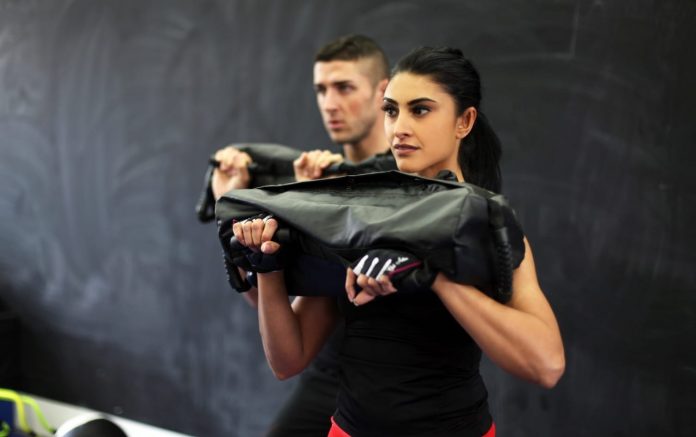When it comes to free weights, dumbbells, kettlebells, and barbells are all good options, but they aren’t your only options. Another effective, though less known piece of equipment? The Bulgarian bag.
This niche tool, which at first glance resembles a giant life-vest-shaped sandbag, isn’t exactly new. But it does have a new fan: Halle Berry.
On Friday, the Academy Award–winning actor shared an Instagram photo of her and her trainer, Peter Lee Thomas, squatting with Bulgarian bags draped around their necks and shoulders. In the caption, Berry explains that Thomas recently introduced her to the tool, and she’s now hooked, using it for a variety of exercises, including strength training, cardio, and plyometric moves.
The Bulgarian bag is basically a souped-up, more comfortable version of a sandbag.
Sandbags are an old-school weight training tool still used today by niche groups like the Navy SEALS and CrossFit athletes and in various group fitness classes. The Bulgarian bag is essentially a nicer iteration of the sandbag, thanks to its soft leather covering, crescent shape that fits snugly around the shoulders, easy-to-grip straps, and stuffing of both sand and wool. Because of this shape and mixed material interior, “the weight doesn’t tend to move around as much as the sandbag will,” Mark DiSalvo, NYC-based certified strength and conditioning specialist, tells SELF, making it easier to wield when performing various exercises.
According to Suples, the Bulgarian bag manufacturer from which Thomas purchased his bags, the tool was created in 2005 by Bulgarian wrestling coach Ivan Ivanov as a functional piece of equipment for his athletes and other combat trainees whose sports require them to perform heavy throwing movements, though it has many other uses.
“It’s a thing you don’t see in most gyms,” Thomas, an instructor with the Thai Boxing Association of America, tells SELF. Thomas has used the bags sporadically over the past decade whenever he came across them at speciality gyms, and only recently bought his own. And it’s quickly become one of his—and Berry’s—favorite pieces of gym equipment.
Compared to other weights, the Bulgarian bag can be a safer, more comfortable, and more versatile option for performing certain exercises.
One of the tool’s biggest perks, says Thomas, is that it is more comfortable than traditional weighted tools. Thomas describes a client who complained of upper-back pain when squatting with a barbell, even when using a pad on the bar. When she switched to the Bulgarian bag, she “could actually squat without major pain.”
It’s also a good implement for training dynamic movements in different directions, like laterally (side-to-side) and transversely (diagonally) that would be difficult and/or unsafe to perform with a barbell, dumbbell, or other weighted tools, says DiSalvo. If you don’t do dynamic sports, performing exercises with the Bulgarian bag can be “a great way to put dynamic movements into your routine,” he adds. “This can help you train your mobility a little bit differently—you get to move your body in a way that is more athletic.”
The bag is also great for swinging movements, like side swings, that can’t be performed safely with a dumbbell, barbell, or plates. On top of that, it’s a great way to train grip strength, thanks to the handles on both ends of the bag that you have to firmly hold as you perform various moves. Grip strength is “paramount” in certain sports, explains Thomas, like rock climbing, Jiu Jitsu, and gymnastics.
One limitation of the Bulgarian bag is that unlike a barbell, on which you can easily load or remove pounds, the weight is fixed. So if your goal is get extremely strong—say, you want to lift really heavy weights—it’s not your best bet, explains DiSalvo, since you can’t progress beyond the heaviest available bag. But if your goal is more to improve your general fitness? “You could get in really great shape with a Bulgarian bag,” he says.
Here are Thomas and DiSalvo’s suggestions for incorporating the Bulgarian bag into workouts.
First, in terms of selecting the appropriate weight, Thomas recommends newbies start light—around 20 pounds—and use bags of different weights so it will feel challenging with different movements. For example, you might want to start with a heavier bag for lower-body movements, like squats, and a lighter bag for upper-body movements, like overhead presses. (If your local gym doesn’t have Bulgarian bags, you can order your own, though, fair warning, they’re pretty pricey, ranging from about $53 to $325 depending on the brand and weight of the bag.)
Once you have a bag, you don’t need to perform advanced or complex moves to reap the benefits. With the Bulgarian bag, and exercise in general, for that matter, “it’s the basics that win,” says Thomas, who suggests using it with an array of traditional exercises—from back squats (like Berry and Thomas demoed), front squats, and overhead presses, to more complex movements like the squat to press and the clean and press. You can also swing it between your legs (like a kettlebell swing) or drape it over your chest “like a baby bib” and perform sit-ups to overhead presses, says Thomas. Or, you can put it on top of your feet and perform sit-ups in place of a partner holding your feet.
You can also hold it in front of your body (racking it in your elbows) to perform lunges, says DiSalvo, or you can drape it over one shoulder and do a set of lunges on that leg, then switch sides, says Thomas. You can also use it to perform side swings, a dynamic move that works the rotation of your spine and engages your obliques, says DiSalvo. You can even just drape it over your shoulders to do carry exercises.
The bottom line: If you’re looking to diversify your strength training and add more dynamic movements to your routine, the Bulgarian bag can be a great, functional option.

























